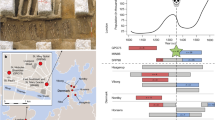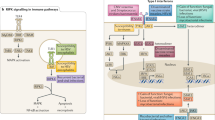Abstract
The pathogenic fungus Histoplasma capsulatum causes disease ranging from mild to fatal in healthy and immunocompromised humans. Infection rates reach 80% in endemic areas, including the Midwestern United States. We used inbred mice to identify a 300-fold difference in fungal burden. A/J mice showed lower fungal burden and morbidity than C57BL/6J mice, a reversal of the trend observed for many bacterial pathogens. We mapped the differences in fungal burden to discrete locations on chromosomes 1, 6, 15 and 17 with high significance. Substitution of a single resistant chromosome 17 onto the susceptible background was sufficient to lower fungal burden. These loci will allow dissection of the fungal-specific immune program.
This is a preview of subscription content, access via your institution
Access options
Subscribe to this journal
Receive 6 digital issues and online access to articles
$119.00 per year
only $19.83 per issue
Buy this article
- Purchase on Springer Link
- Instant access to full article PDF
Prices may be subject to local taxes which are calculated during checkout




Similar content being viewed by others
References
Fiese MJ . Coccidioidomycosis. Thomas: Springfield IL, 1958.
Retallack DM, Woods JP . Molecular epidemiology, pathogenesis, and genetics of the dimorphic fungus Histoplasma capsulatum. Microbes infect 1999; 1: 817–825.
Deepe Jr GS . Immune response to early and late Histoplasma capsulatum infections. Curr Opin Microbiol 2000; 3: 359–362.
Brown GD, Herre J, Williams DL, Willment JA, Marshall AS, Gordon S . Dectin-1 mediates the biological effects of beta-glucans. J Exp Med 2003; 197: 1119–1124.
Gross O, Gewies A, Finger K, Schafer M, Sparwasser T, Peschel C et al. Card9 controls a non-TLR signalling pathway for innate anti-fungal immunity. Nature 2006; 442: 651–656.
Hubner N, Wallace CA, Zimdahl H, Petretto E, Schulz H, Maciver F et al. Integrated transcriptional profiling and linkage analysis for identification of genes underlying disease. Nat Genet 2005; 37: 243–253.
Liang Y, Jansen M, Aronow B, Geiger H, Van Zant G . The quantitative trait gene latexin influences the size of the hematopoietic stem cell population in mice. Nat Genet 2007; 39: 178–188.
Kramnik I, Boyartchuk V . Immunity to intracellular pathogens as a complex genetic trait. Curr Opin Microbiol 2002; 5: 111–117.
Chick EW, Roberts GD . The varying susceptibility of different genetic strains of laboratory mice to Histoplasma capsulatum. Mycopathol Mycol Appl 1974; 52: 251–253.
Deepe GS . Histoplasma capsulatum and V beta a mice: cellular immune responses and susceptibility patterns. J Med Vet Mycol 1993; 31: 181–188.
Fierer J, Walls L, Wright F, Kirkland TN . Genes influencing resistance to Coccidioides immitis and the interleukin-10 response map to chromosomes 4 and 6 in mice. Infect Immun 1999; 67: 2916–2919.
Wu-Hsieh B . Relative susceptibilities of inbred mouse strains C57BL/6 and A/J to infection with Histoplasma capsulatum. Infect Immun 1989; 57: 3788–3792.
Nesbitt MN, Skamene E . Recombinant inbred mouse strains derived from A/J and C57BL/6J: a tool for the study of genetic mechanisms in host resistance to infection and malignancy. J Leukoc Biol 1984; 36: 357–364.
Singer JB, Hill AE, Burrage LC, Olszens KR, Song J, Justice M et al. Genetic dissection of complex traits with chromosome substitution strains of mice. Science 2004; 304: 445–448.
Sampson SB, Higgins DC, Elliot RW, Taylor BA, Lueders KK, Koza RA et al. An edited linkage map for the AXB and BXA recombinant inbred mouse strains. Mamm Genome 1998; 9: 688–694.
Shifman S, Bell JT, Copley RR, Taylor MS, Williams RW, Mott R et al. A high-resolution single nucleotide polymorphism genetic map of the mouse Genome. PLoS Biol 2006; 4: e395.
Southam DS, Dolovich M, O'Byrne PM, Inman MD . Distribution of intranasal instillations in mice: effects of volume, time, body position, and anesthesia. Am J Physiol 2002; 282: L833–L839.
Rappleye CA, Eissenberg LG, Goldman WE . Histoplasma capsulatum alpha-(1,3)-glucan blocks innate immune recognition by the beta-glucan receptor. Proc Natl Acad Sci USA 2007; 104: 1366–1370.
Tewari RP, Berkhout FJ . Comparative pathogenicity of albino and brown types of Histoplasma capsulatum for mice. J Infect Dis 1972; 125: 504–508.
Lander E, Kruglyak L . Genetic dissection of complex traits: guidelines for interpreting and reporting linkage results. Nat Genet 1995; 11: 241–247.
Yan BS, Kirby A, Shebzukhov YV, Daly MJ, Kramnik I . Genetic architecture of tuberculosis resistance in a mouse model of infection. Genes Immun 2006; 7: 201–210.
Woods JP, Heinecke EL, Goldman WE . Electrotransformation and expression of bacterial genes encoding hygromycin phosphotransferase and beta-galactosidase in the pathogenic fungus Histoplasma capsulatum. Infect Immun 1998; 66: 1697–1707.
Zar JH . Biostatistical Analysis, 4th edn. Prentice Hall: Upper Saddle River, NJ, 1999.
Manly KF, Cudmore Jr RH, Meer JM . Map Manager QTX, cross-platform software for genetic mapping. Mamm Genome 2001; 12: 930–932.
Acknowledgements
We thank Nina Hahn and Bob Williams for animal assistance, Leonid Teytelman for database help, LeRoy Brown and Carl Millward for histopathology services, and Lena Hwang and Rachel Brem for critical reading of the manuscript. JR is supported by NIH Grants GM31105 and GM35827. JM was supported by NIH Grant HG00047 and was a Damon Runyon Cancer Research Fund fellow.
Author information
Authors and Affiliations
Corresponding author
Additional information
Supplementary Information accompanies the paper on Genes and Immunity website (http://www.nature.com/gene)
Supplementary information
Rights and permissions
About this article
Cite this article
Mayfield, J., Rine, J. The genetic basis of variation in susceptibility to infection with Histoplasma capsulatum in the mouse. Genes Immun 8, 468–474 (2007). https://doi.org/10.1038/sj.gene.6364411
Received:
Revised:
Accepted:
Published:
Issue Date:
DOI: https://doi.org/10.1038/sj.gene.6364411
Keywords
This article is cited by
-
Histoplasma yeast and mycelial transcriptomes reveal pathogenic-phase and lineage-specific gene expression profiles
BMC Genomics (2013)
-
Susceptibility to Coccidioides species in C57BL/6 mice is associated with expression of a truncated splice variant of Dectin-1 (Clec7a)
Genes & Immunity (2008)
-
Sex differences in the genetic architecture of susceptibility to Cryptococcus neoformans pulmonary infection
Genes & Immunity (2008)



